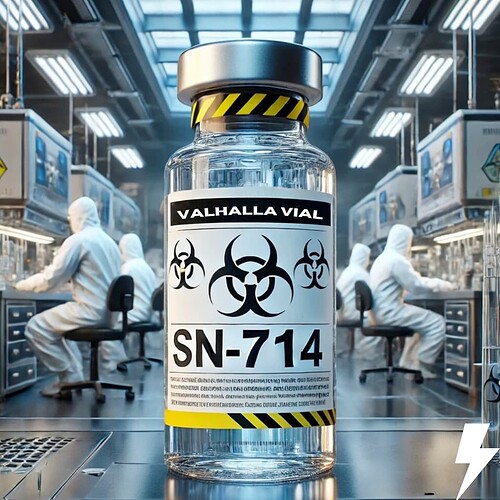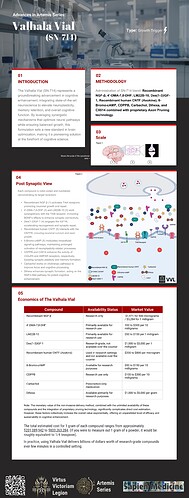More
The Valhalla Vial (aka SN-714) is the first Legion-level brain booster at the tip of neuroscience research.
NR2B works synergistically with Clotho and Cloq10 to unlock the full potential of your cognitive abilities, backed by the following cutting-edge components:
-
Recombinant NGF-β: A highly stable, long-lasting form of nerve growth factor that remains active for days. This ensures prolonged neural regeneration and repair, facilitating deeper and more sustained neuroplasticity, which is crucial for learning and memory enhancement.
-
4’-DMA-7,8-DHF: A synthetic flavone that surpasses its natural counterpart, 7,8-DHF, which itself is more effective than BDNF in promoting neurogenesis. This advanced molecule not only supports the growth of new neurons but also enhances synaptic connectivity, elevating cognitive functions to their peak.
-
LM22B-10: This small molecule mimics the effects of BDNF, reinforcing synaptic strength and promoting brain plasticity, thus aiding in the maintenance of long-term cognitive performance.
-
Des(1-3)IGF-1: A potent variant of IGF-1 that omits the first three amino acids, resulting in a molecule with 10 times greater potency and affinity. This leads to accelerated neurogenesis and heightened synaptic repair, driving cognitive resilience and adaptability.
-
Recombinant human CNTF (Axokine): An enhanced version of CNTF, three to five times more potent, supporting neuronal survival and axon growth. This significantly bolsters the brain’s natural capacity to heal and adapt, making it a cornerstone of long-term cognitive enhancement.
-
8-Bromo-cAMP: A more stable and potent analogue of cAMP, crucial for intracellular signaling. By maintaining prolonged signaling pathways, it ensures sustained activation of neuroplasticity-related processes, optimizing learning and memory.
-
CDPPB: Enhances mGluR5 receptor activity, creating a synergistic effect with BDNF signaling that is critical for synaptic plasticity and cognitive flexibility. This dual-action mechanism enhances the brain’s adaptability to new information and experiences.
-
Carbachol: A brain-targeted acetylcholine analog that amplifies cholinergic signaling without peripheral side effects (ie: bowel movements). This ensures enhanced focus, memory recall, and overall cognitive processing.
-
Dihexa: A compound renowned for its ability to promote synaptogenesis and cognitive enhancement. Up to 10,000,000x more potent than BDNF. By boosting the formation of new synaptic connections, it elevates mental clarity and problem-solving abilities.
-
CX614: A powerful AMPAR activator that facilitates long-term potentiation (LTP) and synaptic growth, driving the formation and retention of long-lasting memories.
Additionally, this blend incorporates next-level axon pruning technology to prevent overgrowth, ensuring that neural networks remain optimized for efficient signaling and information processing.
Artemis series
… For the legends




